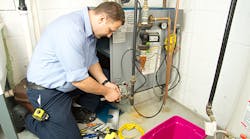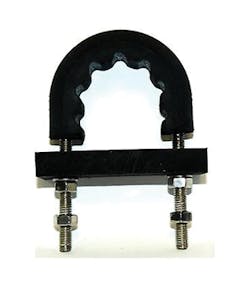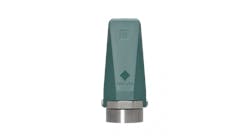This column is moderated by Béla Lipták, automation and safety consultant and editor of the Instrument and Automation Engineers' Handbook (IAEH). If you have an automation-related question for this column, write to [email protected].
Q: I have a question/problem related to a vibrating gas line. I recently had my home furnace cleaned—its annual cleaning. It's two years old and is a high-efficiency type with 110,000 btu. During the cleaning, the burners were removed, cleaned and reinstalled. After the furnace was cleaned and reassembled, the furnace began making a humming noise; actually, the gas pipe is vibrating in the furnace room. This happens when the furnace calls for high heat, but never on low heat. Prior to the cleaning, it was very quiet, no hum or vibration. The hum is very annoying and awakens me at night as our bedroom is above the furnace room. The gas line in the furnace room is black iron. It's 1 in. diameter at the input and tees off to 2½ in. lines, serving the furnace and hot water heater. The hot water heater has a pilot valve and typically isn't running when this happens. The service technician checked the pressure at the furnace gas valve and it was to specification with virtually no pressure drop when the furnace called for high heat. Any idea as to what the problem is? The hum is driving me crazy, and the furnace people are stumped at solving this. Thank you.
C. Marchetti
[email protected]
A1: The natural frequencies of piping systems depend on the distribution of mass and stiffness, which are influenced by piping diameter, material properties, wall thickness, location of lumped masses (such as valves), piping supports and fluid density. When a piping system is subject to dynamic excitation with a frequency that coincides with its natural frequencies, it resonates. Natural frequency pipe vibration is a complex phenomenon and, in your case, I would focus on eliminating the symptom instead of determining the cause.
Figure 1: Anti-vibration rubber lined U-bolt and backing pad
It's probable that the reassembly of the cleaned furnace resulted in some change that didn't exist prior to cleaning. The fact that vibration-initiated noise evolves only at high gas flows indicates that the increase in turbulence (high Reynolds Number) generated forces that cause the vibration. You can check if this is so by pressing on the vibrating pipe. If the noise stops, then you're close to the noise source. At that location, you can install some noise-isolating fasteners to secure the gas line. You could also lower the Reynolds Number by increasing the line size, but that's too much trouble.
My guess is that the fuel gas line isn't properly mounted. If it's fastened to the underside of floor joists over a basement joist, the whole floor structure can act as a speaker amplifier. Therefore, I'd just secure the line with anti-vibration, rubber-lined U-bolts (Figure 1) provided with backing pads to secure the line.
Béla Lipták
[email protected]
A2: I believe this is a flow-induced vibration. A newly cleaned burner has a larger nozzle after the soot is removed. A slight change in flow of the fuel may cause a drift in the natural frequency of the system, in turn, causing the piping to vibrate when high heat is required. You may want to check all the piping fasteners as they tend to get loose with vibration. Additional fasteners may be needed. In power plants, we have changed the natural frequency by fastening a huge mass of metal on a vibrating pipe, thus eliminating the vibrations altogether. I don't believe that the vibrations in your case were structural, which are usually low-frequency vibrations.
If your vibration problem existed in an industrial application, involving a larger diameter pipe, to be safe, you'd determine vibration displacements, velocities and accelerations measured against frequencies and analyzed by qualified professionals. In addition, make sure the dangerous vibration level (0.5 inches/s rms total) hasn't been exceeded.
Cleaning parts in wet contact with fuel can also change the internal surface roughness, and thus the flow coefficient (k-factor) of the Darcy equation, which in turn can affect the flow of the fuel for a given pressure drop. I'd keep everything the same in order to keep the loss coefficient as close to the previous loss coefficient (before furnace cleaning) as possible. Changing more variables can make it difficult to identify the cause of the problem.
The loss coefficient can be calculated using Crane Technical Publication 410 (Flow Through Valves, Piping, and Fittings). I've successfully derived the equation used by Crane Technical Publication 410. It's a very useful equation because Cv/area can be expressed in terms of the upstream loss coefficient k. Hence, one doesn't need to know Cv/area numerically. When the “required Cv” for an application is calculated, one can use the "required Cv"/[Cv/area] to find out the area (in square inches) which is the "effective flow area" of a given application. This is the effective flow area calculated (usually a bit smaller than the physical flow area) because it's in terms of the upstream loss coefficient, k. After knowing the effective flow area, one can calculate the exitfluid velocity to see if the fluid flow is sonic or subsonic at exit conditions. This is very important, because sonic flow can create shock waves and vibrations. Many root causes of control valve failures were found based on this method when I was the senior control valve investigator at my former company.
Gerald Liu, consultant,
professional engineer
[email protected]
A3: I do not understand why furnace people insist on hard piping everything. They should use flexible stainless steel for the last section connected to the furnace (12 to 18 inches). When they reassembled your piping, they probably didn't align everything 100%. Flexibility is the answer (there is a code specification for the flexible tubing).
Simon Lucchini, CFSE,
MIEAust CPEng (Australia)
Chief Controls Specialist, Fluor Fellow in Safety Systems
[email protected]
A4: When gas furnaces are cleaned, sometimes the person cleaning either removes or adjusts the clamps and tie-downs, and they have to be replaced. Another possible cause of vibration can be if the 1-in or 1/2-in lines are crimped somewhere along the route.
Alejandro (Alex) Varga Meder
Senior Project Manager
[email protected]
Polar Vortex
Q: I read your article “Understanding the polar vortex process,” and I have a question for you. In the 1970s, the same weather phenomenon was sometimes interpreted as an indication of global cooling. Maybe the polar vortex is simply part of our coupled, non-linear chaotic climate system and not an indication of global cooling or global warming. What are your thoughts?
Don Williams
geology student with PhD aspirations
[email protected]
A1: The scientific community is split on this. Some calculated that global warming is influencing polar vortex formation, while others disagree. On the other hand, all scientists agree that the North Pole is warming four times faster than the planet and some believe that the resulting reduction in the difference between polar temperatures and the temperatures further south could cause the vortex to break up and cause the cold air to move periodically.
I know it's counterintuitive that general warming could cause localized cooling, but some argue it can happen. For example, some suggest that global warming can cool Europe if it causes the Gulf current to slow and thereby carry less heat to the north.
All I know is that global warming is a very complex process that can both amplify or reduce the effects of natural processes (for example flooding and drought), and also that it's long-range effect can differ from the short-range one. (I deal with this in some detail in my book: "Controlling the Future," published by ISA). In other words, we should distinguish weather from climate because the time constants of global warming has influence on them both.
Béla Lipták
[email protected]






